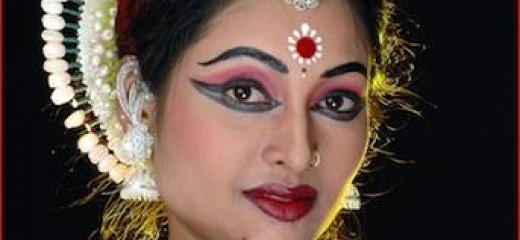
Photo: Aurobinda Mohapatro
Virtue and Virtuosity: Shibani Patnaik at the Performance Garage
by Lynn Brooks
The room was low and dark, the backdrop a gray-white sheet, but the dancing and music were aglow, conjuring worlds, and ways, and wisdom. Solo dancer Shibani Patnaik, with four musicians – Bijaya Kumar Barik, percussion; Ramesh Chandra Das, violin; Jabahar Mishra, flute; and Rupak Kumar Parida, voice – form the “Samsara team,” as Patnaik referred to them in the course of her remarks to the audience. But “team” hardly does them justice. They became one force breathing into, flowing through, shaping, and accenting the evening’s presentation of Samsara—The Cycle of Life.
I knew little of Odissi dance of India beyond what I had read on the artist’s website. Nor had I ever heard of Ms. Patnaik, who has been living in Philadelphia for the past four years. Although a native of California, she trained extensively in India in Odissi dance, a form that barely survived British rule on the subcontinent but now has adherents throughout the world. Watching Patnaik’s finely wrought performance, I wondered why I had never heard of her and pondered the circles of dance – of art – that I inhabit. Odissi does not penetrate my typical sphere of concern, nor do I seek it out. How fortunate that I encountered her, and her collaborators, this evening!
The show began with an invocation, Pancha Bhuta, in which Patnaik connected to the earth, rippled as watery waves, shimmered like fire, sailed on the wind, and seemed to hover in the sky. In the second dance, Pallavi, drawing on the poses of temple sculptures that form Odissi’s foundation, I noted that the dancer’s lively rhythms, interspersed with sudden stillnesses, exactly matched the musical phrasing—a match evident throughout the evening. This energetic piece was followed by Abhinaya, a story of gods Radha and Krishna, whose mutual desire has set the town ablaze with rumors. The dancer became Radha, Krishna, and the narrator in succession. Emotions of love, shame, flirtation, fear, and surrender washed over her as she carried the tale through the town, the forests, and the river where Radha bathed.
Patnaik gave herself fully to these three works, sustaining unfailing control, full emotional expression, and movement ranging from the most precise glance or finger curl to full-bodied stretches, jumps, and poses. In the Performance Garage’s intimate space, I could see that she was sweat-soaked, and I pondered that she still had two numbers to go.
In Barsha Barnalee, which followed intermission, Patnaik communicated the delicate dripping of raindrops through her exquisite mudras, which gave way to exuberant swaying and swimming through a river in flood. The last dance, Samsara—The Cycle of Life, gave the show its title, and it was the only work credited to Patnaik as choreographer. (Other works were by Gurus Aruna Mohanty and Gangadhar Pradhan). She generously spoke an introduction to this dance and also interspersed her energetic and refined dancing with commentary to carry the audience along. I was grateful for this kindness on Patnaik’s part—her care in communicating her message—yet her precise performance, highly legible mimetic gestures, and expressive face told the story clearly. I saw her dance humankind’s worldly attachments, the soul’s passage from birth to old age, and the release of enlightenment, embodied in an ecstasy of whirling that concluded in perfect repose.
The beauty of Patnaik’s dancing was supported not only by the musicians, but also by stunning costumes and elaborate make-up that adorned her, literally, from tip to toe. Less effective was the too-busy lighting that changed from one dark hue to another every few seconds, casting odd shadows around the stage, and at times leaving Patnaik almost in the dark. In Samsara, a film showing raindrops on leaves and flowers distracted attention from the dancer’s opening remarks. These elements clashed with the perfection of her controlled movement, rhythm, and expression. I could also have happily missed an emcee’s word-for-word reading, at the start of the already late show, of the program notes. And, in so intimate a room, did the music have to be amplified?
Sitting at the performance, I realized I was one of the few people in the audience who was not somehow connected with the artist, or at least with her community. I felt myself the outsider. But as the show progressed, I gratefully accepted Patnaik’s generous gifts – of herself, of her art, of stories that resonated in me, no longer the outsider, but merging into the river of universal life, a river she so eloquently mimed in the course of the evening.
Samsara — The Cycle of Life, Shibani Patnaik, the Performance Garage, May 20, 2012. This performance was part of a national tour.
By Lynn Matluck Brooks
May 22, 2012

